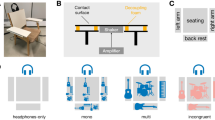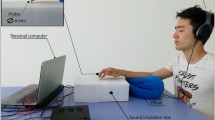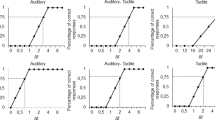Abstract
Previous investigations have revealed that the complex sensory exposure of musical training alters audiovisual interactions. As of yet, there has been little evidence on the effects of musical training on audiotactile interactions at a behavioural level. Here, we tested audiotactile interaction in musicians using the audiotactile illusory flash and the parchment-skin illusion. Significant differences were only found between musicians and non-musicians for the audiotactile illusory flash. Both groups had similar task-relevant unisensory abilities, but unlike non-musicians, the number of auditory stimulations did not have a statistically important influence on the number of perceived tactile stimulations for musicians. Musicians and non-musicians similarly perceived the parchment-skin illusion. Spectral alterations of self-generated palmar sounds similarly altered the perception of wetness and dryness for both groups. These results suggest that musical training does not seem to alter multisensory interactions at large. The specificity of the sensory enhancement suggests that musical training specifically alters processes underlying the interaction of temporal audiotactile stimuli and not the global interaction between these modalities. These results are consistent with previous unisensory and multisensory investigations on sensory abilities related to audiotactile processing in musicians.



Similar content being viewed by others
Abbreviations
- SI:
-
Susceptibility index
References
Bresciani JP, Dammeier F, Ernst MO (2006) Vision and touch are automatically integrated for the perception of sequences of events. J Vis 6:554–564
Champoux F, Collignon O, Bacon BA, Lepore F, Zatorre RJ, Théoret H (2010) Early-and late-onset blindness both curb audiotactile integration on the parchment-skin illusion. Psychol Sci 22:19–25
Cohen J, MacWhinney B, Flatt M, Provost J (1993) PsyScope: an interactive graphic system for designing and controlling experiments in the psychology laboratory using Macintosh computers. Behav Res Methods Instrum Comput 25:257–271
Elbert T, Pantev C, Wlenbruch C, Rockstroh B, Taub E (1995) Increased cortical representation of the fingers of the left hand in string players. Science 270:305–307
Foxe JJ (2009) Multisensory integration: frequency tuning of audio-tactile integration. Curr Biol 19:R373–R375
Fujisaki W, Nishida SY (2009) Audio-tactile superiority over visuo-tactile and audio-visual combinations in the temporal resolution of synchrony perception. Exp Brain Res 198:245–259
Guest S, Catmur C, Lloyd D, Spence C (2002) Audiotactile interactions in roughness perception. Exp Brain Res 146:161–171
Herholz SC, Zatorre RJ (2012) Musical training as a framework for brain plasticity: behavior, function, and structure. Neuron 76:486–502
Hodges DA, Hairston WD, Burdette JH (2005) Aspects of multisensory perception: the integration of visual and auditory information in musical experiences. Ann NY Acad Sci 1060:175–185
Hong KS, Santosa H (2016) Decoding four different sound-categories in the auditory cortex using functional near-infrared spectroscopy. Hear Res 333:157–166
Hötting K, Röder B (2004) Hearing cheats touch, but less in congenitally blind than in sighted individuals. Psychol Sci 15:60–64
Hyde KL, Lerch J, Norton A, Forgeard M, Winner E, Evans AC, Schlaug G (2009) The effects of musical training on structural brain development: a longitudinal study. Ann NY Acad Sci 1169:182–186
Jousmäki V, Hari R (1998) Parchment-skin illusion: sound-biased touch. Curr Biol 8:R190
Kuchenbuch A, Paraskevopoulos E, Herholz SC, Pantev C (2014) Audio-tactile integration and the influence of musical training. PLoS ONE 9:e85743
Landry SP, Guillemot JP, Champoux F (2013) Temporary deafness can impair multisensory integration: a study of cochlear-implant users. Psychol Sci 24:1260–1268
Lappe C, Herholz SC, Trainor LJ, Pantev C (2008) Cortical plasticity induced by short-term unimodal and multimodal musical training. J Neurosci 28:9632–9639
Lee H, Noppeney U (2011) Long-term music training tunes how the brain temporally binds signals from multiple senses. Proc Natl Acad Sci USA 108:E1441–E1450
Lee H, Noppeney U (2014) Music expertise shapes audiovisual temporal integration windows for speech, sinewave speech, and music. Front Psychol 5:868
Luo C, Guo ZW, Lai YX, Liao W, Liu Q, Kendrick KM, Yao DZ (2012) Musical training induces functional plasticity in perceptual and motor networks: insights from resting-state fMRI. PLoS ONE 7:e36568
McGurk H, MacDonald J (1976) Hearing lips and seeing voices. Nature 264:746–748
Moreno S, Marques C, Santos A, Santos M, Castro SL, Besson M (2009) Musical training influences linguistic abilities in 8-year-old children: more evidence for brain plasticity. Cereb Cortex 19:712–723
Müllensiefen D, Gingras B, Musil J, Stewart L (2014) The musicality of non-musicians: an index for assessing musical sophistication in the general population. PLoS ONE 9:e89642
Münte TF, Altenmüller E, Jäncke L (2002) The musician’s brain as a model of neuroplasticity. Nat Rev Neurosci 3:473–478
Musacchia G, Sams M, Skoe E, Kraus N (2007) Musicians have enhanced subcortical auditory and audiovisual processing of speech and music. Proc Natl Acad Sci USA 104:15894–15898
Musacchia G, Strait D, Kraus N (2008) Relationships between behavior, brainstem and cortical encoding of seen and heard speech in musicians and non-musicians. Hear Res 241:34–42
Nasir SM, Ostry DJ (2008) Speech motor learning in profoundly deaf adults. Nat Neurosci 11:1217–1222
Pantev C, Oostenveld R, Engelien A, Ross B, Roberts LE, Hoke M (1998) Increased auditory cortical representation in musicians. Nature 392:811–814
Pantev C, Paraskevopoulos E, Kuchenbuch A, Lu Y, Herholz SC (2015) Musical expertise is related to neuroplastic changes of multisensory nature within the auditory cortex. Eur J Neurosci 41:709–717
Petrini K, Dahl S, Rocchesso D, Waadeland CH, Avanzini F, Puce A, Pollick FE (2009) Multisensory integration of drumming actions: musical expertise affects perceived audiovisual asynchrony. Exp Brain Res 198:339–352
Santosa H, Hong MJ, Hong KS (2014) Lateralization of music processing auditory cortex: an fNIRS study. Front Behav Neurosci 8:418
Schultz M, Ross B, Pantev C (2003) Evidence for training-induced cross modal reorganization of cortical functions in trumpet players. NeuroReport 14:157–161
Schwartz JL (2010) A reanalysis of McGurk data suggests that audiovisual fusion in speech perception is subject-dependent. J Acoust Soc Am 127:1584–1594
Stein BE, Stanford TR (2008) Multisensory integration: current issues from the perspective of a single neuron. Nat Rev Neurosci 9:255–266
Stevenson RA, Zemtsov RK, Wallace MT (2012) Individual differences in the multisensory temporal binding window predict susceptibility to audiovisual illusions. J Exp Psychol Hum Percept Perform 38:1517–1529
Wallace MT, Stein BE (2007) Early experience determines how the senses will interact. J Neurophysiol 97:921–926
Wollman I, Fritz C, Poitevineau J (2014) Influence of vibrotactile feedback on some perceptual features of violins. J Acoust Soc Am 136(2):910–921
Yau JM, Olenczak JB, Dammann JF, Bensmaia SJ (2009) Temporal frequency channels are linked across audition and touch. Curr Biol 19:561–566
Zatorre RJ, Belin P (2001) Spectral and temporal processing in human auditory cortex. Cereb Cortex 11:946–953
Acknowledgements
The authors would like to thank J. Roy for her help in the preliminary data collection and their funding sources: the Canadian Institutes of Health Research, Fonds de Recherche du Québec—Santé, and Natural Sciences and Engineering Research Council of Canada.
Author information
Authors and Affiliations
Corresponding author
Rights and permissions
About this article
Cite this article
Landry, S.P., Sharp, A., Pagé, S. et al. Temporal and spectral audiotactile interactions in musicians. Exp Brain Res 235, 525–532 (2017). https://doi.org/10.1007/s00221-016-4813-3
Received:
Accepted:
Published:
Issue Date:
DOI: https://doi.org/10.1007/s00221-016-4813-3




